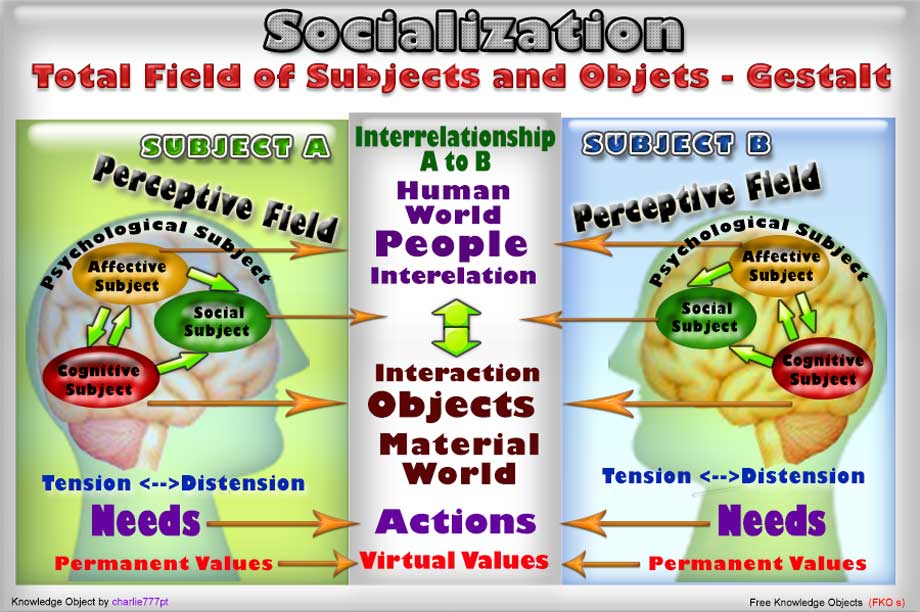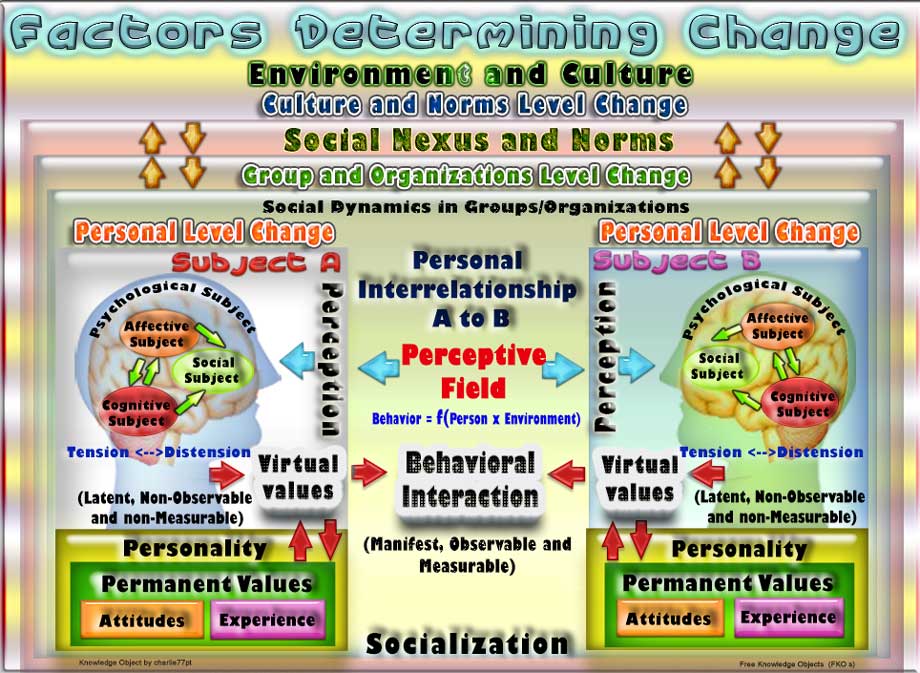<h3>Social Reality: Violence, Power, and Change
Factors determining Change -Part 2 - Complex version</h3>
<strong>"Change is the only static Truth, and Participation is the key"</strong> - charlie777pt<h3>Introduction </h3>
This is a very <strong>heavy part to read</strong> and is most directed to <strong>academic and scientific social psychology approach,</strong> and it is necessary to <strong>use the graphics</strong> below to understand this <strong>difficult conceptualization of complex thought that can't be made too simple.</strong>
Most of this writings in part are based in my own views, that contains a lot of reading a lot of authors of theories about these subjects, that I filtered with my own experience.<h3>1- What makes a change?</h3> <blockquote><strong>"The world as we have created it is a process of our thinking. It cannot be changed without changing our thinking"</strong>. <em>-Albert Einstein</em></blockquote><strong>Social change is connected to behavior patterns, cultural values, and norms.</strong>

People <strong>report themselves to a scale of Permanent Values</strong>, based in the <strong>3 intra-psychic subjects, </strong>the <strong>Cognitive, the Affective, and the Social,</strong> determining their <strong>attitudes, that are dispositions for predetermined behavior patterns.</strong>
When exposed to <strong>social dynamics situations</strong> we are in an <strong>interrelationship of people</strong>, where they have to <strong>virtualize their Permanent Values </strong>(causing tension and anxiety), and <strong>confront these Virtual Values</strong>, until the interaction is over.
<strong>After the interaction people</strong> <strong>reabsorb the conflicting tendencies</strong>, by going back to their <strong>scale of Permanent Values</strong> and restore <strong>equilibrium</strong> by the resulting<strong> psychic distension.</strong>
In this<strong> process of mutual virtualization of values we learn and adapt</strong>, making our<strong> permanent values more flexible</strong>, with less resistant to change, but they <strong>will always remain permanent but not static.</strong>
For example, you could have been <strong>educated to be a racist</strong>, but if you have to live in a village with that people you have <strong>preconceptions and stereotypes influencing perception of them</strong>, after some time you are adapted and by humanization of the others and you <strong>even forget you are a racist</strong> in your permanent values, but deep down it's not true, but you even lost the anxiety of confrontation because <strong>your permanent values have become total "elastic".</strong>
The <strong>ego malleability</strong> of <strong>knowing, analyzing, and exposing our permanent values in the virtualization of face-to-face communication </strong>(and interpret our mechanisms of anxiety ), is the key for personal freedom and a life with the pleasure of surfing the waves of change. <blockquote><strong>"As you begin to realize that every different type of music, everybody's individual music, has its own rhythm, life, language and heritage, you realize how life changes, and you learn how to be more open and adaptive to what is around us."</strong> - Yo-Yo Ma</blockquote>I would risk to say that <strong>adaptation to the modernization of society</strong>, will demand an <strong>increasingly development of our emotional intelligence </strong>(of the Affective Subject) by <strong>human contact</strong>, to<strong> expand our Social Subjec</strong>t and at the same time have an<strong> hyper-curiosity to develop our Cognitive Subject conceptions of the world.</strong>
We must never forget that an<strong> aseptic relation with the cold screens in between people</strong> is<strong> not the same as face-to-face </strong>communication.
<strong>Change in interactions and relationships </strong>transform <strong>people's attitudes and behaviors, groups and social institutions</strong> affecting culture, and leading to the <strong>acceptance of new social norms and rules</strong>.<blockquote><strong>"Change before you have to."</strong> <em>- Jack Welch</em></blockquote> <h3>2 - A complex and global vision</h3>
All <strong>social groups and subgroups</strong> (institutions and groups) impose <strong>themselves as "totalities" that are dynamic</strong> and with chains of <strong>transformation and self-regulation</strong> (cybernetics) are made s<strong>pecifically by norms or rules</strong> imposed by the group on the <strong>dynamics of relations interindividuals</strong>, resulting in a <strong>progressive internalization of actions by each individual.</strong>

This System is a<strong> Gestalt (form) </strong>of a <strong>relational totality</strong> as a <strong>system of interactions</strong> that <strong>modifies individuals</strong> from the beginning and which on the other hand<strong> explains the variations of the Whole.</strong>
In the <strong>analysis of the systems forming processes </strong>we find a deep<strong> identity of nature </strong>(isomorphism) between the <strong>operations of individual thought </strong>and those that are<strong> inherent to the whole process of social cooperation</strong> (praxeology).
The objective will be to study the<strong> interindividual relations and the dynamics</strong> of the group in the relation with the <strong>mechanisms of intraindividual knowledge</strong>, and on the other with the <strong>norms and social rules</strong> that surround the<strong> field where the action</strong> takes place.
Kurt Lewin studied the <strong>perceptual and affective fields</strong> (a gestalt that includes the subject and their reactions) and the <strong>dynamics of sets of these fields</strong>, which reveal <strong>oppositions or inhibitions and psychic barriers</strong>, depend on the overall structure of the field, and the most <strong>pressing needs of individuals</strong>.
Each <strong>action precedes a necessity </strong>that is <strong>linked to the system</strong> and which <strong>favors or disadvantages its execution,</strong> a<strong> necessity that is linked to values</strong> that also depend on the <strong>surrounding social system.</strong>
It is important to take into account the <strong>condition of needs and values in relation to the object </strong>and not only the <strong>cognitive forms.</strong>
The great <strong>theoretical difficulty</strong> is to <strong>characterize the affective life in relation to the cognitive functions</strong> and <strong>precise them in the functioning the conducts.</strong>
Lewin and Bruner speak of <strong>conducts as a function of a total field</strong> (subjects and objects) according to <strong>gestalt</strong>, corresponding the <strong>structure of this field </strong>to perceptions, acts of intelligence, etc. while<strong> its dynamics determines the functioning</strong> by assigning positive or negative values to objects (<strong>Attraction</strong> = + = positive, and <strong>Repulsion</strong> = - = negative)
Before <strong>any act of will </strong>there are always <strong>two conflicting tendencies</strong>, which are not absolute but relative to the <strong>perceptual situation of the moment.</strong>
Any <strong>perception is as much social </strong>and tied to<strong> affective appreciation as purely cognitive,</strong> as is a product of<strong> momentary overestimates and underestimates</strong> that determine will, as a <strong>model of reversible operations</strong> (opposing energetic regulations) that <strong>corrects the estimates leading to momentary values </strong>to reach the scale of permanent values, creating the <strong>modification of the weak (affective) in stronger.</strong>
The <strong>act of will </strong>is then an <strong>active decentration of the subject in relation to the present situation </strong>in order to allow a <strong>return to the permanent values of its internal scale.</strong>
The <strong>non-innate co-ordination factor of the actions,</strong> that is affirmed in its <strong>functional development</strong> is the element of <strong>equilibrium, </strong>which as <strong>cybernetic self-regulation</strong> (such as organic homeostasis) is<strong> based on the subject's active compensations for external modifications.</strong>
We have to keep in mind that we have always <strong>attitudes embedded in needs</strong>, on a <strong>scale of permanent value</strong>s, to which we<strong> report at the time of conflict</strong> and determine a certain <strong>predisposition for the action</strong> to which the object of the <strong>attitude refers</strong>, implied by the current situation.
<strong>Attitudes are developed in accordance with the needs,</strong> which arise and are structured according <strong>to their social insertion.</strong>
Here ends a<strong> post that required a great effort of reading</strong>, for which I thank all who have <strong>managed to reach the end</strong>.
In the next post we will talk about the paths of Change.<h3><strong>Last posts in this series on Social Reality: Violence, Power and Change</strong>
<strong>Introduction:</strong></h3><a href="https://steemit.com/psychology/@charlie777pt/social-reality-violence-power-and-change">Social Reality: Violence, Power and Change</a><h3><strong>A - Violence:</strong></h3><a href="https://steemit.com/psychology/@charlie777pt/an-introduction-to-violence"> An Introduction to Violence</a>
<a href="https://steemit.com/psychology/@charlie777pt/the-concepts-of-violence-aggression-and-aggressivity">The Concepts of Violence, Aggression, and Aggressiveness </a>
<a href="https://steemit.com/psychology/@charlie777pt/the-theories-on-violence">The Theories on Violence </a>
<a href="https://steemit.com/psychology/@charlie777pt/the-influencers-of-violence-part-one-culture-and-social-context">The influencers of Violence -Part One - Culture and Social Context</a>
<a href="https://steemit.com/psychology/@charlie777pt/the-influencers-of-violence-part-two-social-cognitive-and-environmental-factors">The influencers of Violence -Part Two - Social , Cognitive and Environmental Factors</a>
<a href="https://steemit.com/psychology/@charlie777pt/the-ascend-of-today-s-violence">The ascend of Today's Violence </a><h3><strong>B -Power:</strong></h3><a href="https://steemit.com/psychology/@charlie777pt/what-is-power-introduction">What is Power? - Introduction</a>
<strong>The Nature of Power</strong><ul><li> <a href="https://steemit.com/psychology/@charlie777pt/the-nature-of-power-part-i-the-notions-of-power">Part I - The Notions of Power</a> </li><li><a href="https://steemit.com/psychology/@charlie777pt/the-nature-of-power-part-ii-the-dimensions-of-power">Part II -The Dimensions of Power</a></li><li><a href="https://steemit.com/psychology/@charlie777pt/the-nature-of-power-part-iii-the-foundations-of-power">Part III -The Foundations of Power</a></li></ul> <strong>The Dynamics of Power</strong>:<ul><li><a href="https://steemit.com/psychology/@charlie777pt/the-dynamics-of-power-part-1-the-legitimacy-of-authority">Part 1 - The Legitimacy of Authority</a></li><li><a href="https://steemit.com/psychology/@charlie777pt/the-dynamics-of-power-part-2-the-models-of-leadership">Part 2 - The Models of Leadership</a></li><li><a href="https://steemit.com/psychology/@charlie777pt/the-dynamics-of-power-part-3-characteristics-of-leadership">Part 3 - Characteristics of Leadership</a></li><li><a href="https://steemit.com/psychology/@charlie777pt/the-dynamics-of-power-part-4-the-relation-in-leadership">Part 4 - The Relation in Leadership</a></li> <li><a href="https://steemit.com/psychology/@charlie777pt/the-dynamics-of-power-part-5-decision-making-and-leadership">Part 5 - Decision-making and Leadership</a></li></ul><strong>The Effects and Consequences of Power</strong><ul><li><a href="https://steemit.com/psychology/@charlie777pt/the-effects-of-power-part-1-philosophical-rally-on-the-matrix-of-power">Part 1- Philosophical Rally on the Matrix of Power</a></li><li><a href="https://steemit.com/psychology/@charlie777pt/the-effects-of-power-part-2-dipravation"> Part 2 - Deprivation </a></li><li><a href="https://steemit.com/psychology/@charlie777pt/the-effects-of-power-part-3-submission">Part 3- Submission</a></li><li><a href="https://steemit.com/psychology/@charlie777pt/the-effects-of-power-part-4-corruption">Part 4- Corruption</a></li> <li> <a href="https://steemit.com/psychology/@charlie777pt/the-effects-of-power-part-5-resistance-to-power">Part 5 - Resistance</a></li><li><a href="https://steemit.com/psychology/@charlie777pt/the-effects-of-power-part-6-power-in-cyberspace">Part 6 - Power in Cyberspace</a></li></ul> <h3>C - Change:</h3><strong><a href="https://steemit.com/psychology/@charlie777pt/change-and-culture-decentralize-all">Change and Culture</a>
<a href="https://steemit.com/psychology/@charlie777pt/the-theories-and-concepts-of-change">The Theories and Concepts of Change</a>
</strong><strong><a href="https://steemit.com/psychology/@charlie777pt/factors-determining-change-part-1-lite-version">Factors determining Change - Part 1 - Lite version</a>
Factors determining Change - Part 2 - Complex version </strong>- this post <h3>Articles from the next series of posts about Social Reality, Violence, Power and Change:
<strong>C - Change:</strong>(cont.)</h3><strong>The Ways of Change - Part 1 - Concepts and Theories
The Ways of Change - Part 2 - Process of Change
A Social Change </strong> <h3>References consulted:</h3><h6>Les concepts fondamentaux de la psychologie sociale - Gustave-Nicolas Fischer
La psychologie sociale - Gustave-Nicolas Fischer
The social-violence dynamics, Power, change - Gustave-Nicolas Fischer, Planeta / ISPA, 1980
<strong>Gustave-Nicolas Fischer is Professor of Psychology and Director of the Psychology Laboratory at the University of Metz.</strong>
French, J. R. P., and Raven, B.H. (1959). The bases of social Power.
Raven, B. H. and Rubin, J. Z. (1976). Social psychology: People in groups
Castel, R. The metamorphoses of the social question. Voices, 1998.
Moscovici, S. (1976). Social influence and social change. London: Academic Press
Michel Foucault, Discipline and Punish: The Birth of the Prison
Festinger, L. (1954). A theory of social comparison processes.
French, J. R. P., Morrison, H. W., and Levinger, G. (1960). Coercive Power and forces affecting conformity
Dahl, R.A. (1957), The Concept of Power.
Giddens, Anthony, <em>Capitalism and Modern Social Theory: An Analysis of the Writings of Marx, Durkheim and Max Weber</em>, 1971.
Grabb, Edward G<em>., Theories of Social Inequality: Classical and Contemporary Perspectives</em>,1990.
Weber, Max, <em>Economy and Society: An Outline of Interpretive Sociology</em>, 1968.
Lewin, K. (1948) ‘Action Research and Minority Problems’, in G.W. Lewin (ed.), Researching Social Conflicts , New York: Harper and Row
Parsons, T. (1966). Societies: Evolutionary and comparative perspectives.
Levy, A. (1986) Second-order planned change: Definition and conceptualization
Watzlawick, P., Weakland, J.H., Fisch, R. (1974) Change: Principles of Problem Formation and Problem Resolution. New York, Norton.</h6> hiveblocks
hiveblocks